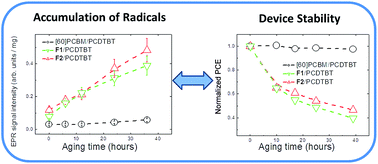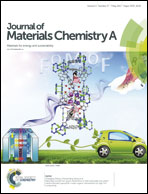Light-induced generation of free radicals by fullerene derivatives: an important degradation pathway in organic photovoltaics?†
Abstract
We present a systematic comparative study of the intrinsic photochemical stability of several fullerene-polymer systems under the natural outdoor conditions in the Negev desert. It has been shown, in particular, that light-induced dimerization of [60]fullerene derivatives is irrelevant to the degradation behavior of the solar cells incorporating these materials in the blends with PCDTBT. The conventional [60]PCBM was shown to undergo rapid and severe photodimerization, when exposed to sunlight, which, however, does not noticeably affect the PCDTBT/[60]PCBM device efficiency. In contrast, two novel fullerene derivatives, which were shown to be far more resistant towards the photodimerization, induced a dramatic failure of the solar cell performance. The application of electron paramagnetic resonance (EPR) spectroscopy allowed us to reveal an alternative photochemical degradation pathway of the fullerene derivatives resulting in the formation of persistent free radicals. The accumulation of free radicals in the active layer was shown to be a critical degradation mechanism, ruining the photovoltaic performance of the devices. These findings strongly suggest that the current understanding of the processes responsible for the “burn-in” failure of organic solar cells has to be reconsidered and additional studies should be performed to clarify the actual mechanisms of the relevant processes.



 Please wait while we load your content...
Please wait while we load your content...